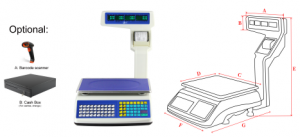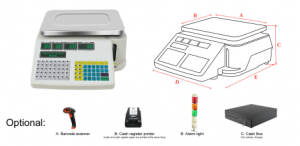Ⅰ:
Toisin kuin mekaaninenvaa'atElektroniset vaa'at käyttävät kokeellisessa punnituksessa sähkömagneettisen voimatasapainon periaatetta ja niissä on sisäänrakennetut punnituskennot, joiden suorituskyky vaikuttaa suoraan elektronisten vaakojen tarkkuuteen ja vakauteen. Erilaiset ulkoiset ympäristöt ja sähkömagneettiset häiriöt vaikuttavat kuitenkin vaakojen tarkkuuteen ja vakauteen, joten elektronisia vaakoja käytettäessä on kiinnitettävä huomiota oikeaan käyttötapaan, sillä se parantaa punnitustarkkuutta ja pidentää käyttöikää. Mitä siis pitäisi tehdä, jos elektroninen vaaka toimii epänormaalisti käytön aikana? Seuraavassa on joitakin yleisiä elektronisten vaakojen viantarkastusmenetelmiä. Kiinnostuneet ystävät saattavat haluta oppia niistä lisää.
II:
Toisin kuin mekaaniset vaa'at, elektroniset vaa'at käyttävät kokeellisessa punnituksessa sähkömagneettisen voimatasapainon periaatetta ja niissä on sisäänrakennetut punnitusanturit, joiden suorituskyky vaikuttaa suoraan elektronisten vaakojen tarkkuuteen ja vakauteen. Erilaiset ulkoiset ympäristöt ja sähkömagneettiset häiriöt vaikuttavat kuitenkin vaakojen tarkkuuteen ja vakauteen, joten elektronisia vaakoja käytettäessä on kiinnitettävä huomiota oikeaan käyttötapaan, sillä se parantaa punnitustarkkuutta ja pidentää niiden käyttöikää. Mitä siis pitäisi tehdä, jos elektroninen vaaka toimii epänormaalisti käytön aikana? Seuraavassa on joitakin yleisiä elektronisten vaakojen viantarkastusmenetelmiä. Kiinnostuneet ystävät saattavat haluta oppia niistä lisää.
III:
Thetarkastus menetelmät elektroniset vaa'at'cyleinen vika:
1. IntuitiivinenMmenetelmä
Elektronisen vaa'an pääpiirilevyllä on monia komponentteja, ja monet viat johtuvat oikosulusta, avoimesta virtapiiristä, pistokkeen ja pistorasian huonosta kosketuksesta sekä komponenttiputkien kulmien avoimesta hitsauksesta. Siksi, kun vaaka pettää, piirilevy on ensin tarkistettava intuitiivisesti: näkö-, kuulo-, haju-, tunto- ja muilla menetelmillä.
2. Vertailu- ja korvausmenetelmä
Vikatarkastuksen aikana elektronista vaakaa voidaan verrata vialliseen vaakaan laitteen avulla, ja vikakohta voidaan löytää nopeasti. Lisäksi, jos anturin, piirilevyn, virtalähteen, näppäimistön ja muiden työssä valmisteltujen komponenttien epäillään olevan vaurioituneita, ne voidaan vaihtaa valmisteltuun komponenttiin ja seurata, muuttuuko tulos. Jos se on normaalia, se tarkoittaa, että alkuperäisessä komponentissa on ongelma. Vertailu- ja korvausmenetelmällä voidaan nopeasti ja tarkasti määrittää vikakohta.
3. JänniteMmittausMmenetelmä
Elektroninen vaaka vertaa piirikomponenttien ja sirun kunkin putkikulman työjännitteen mittausta normaaliarvoon. Paikka, jossa jännite muuttuu suuresti, on vian sijainti.
4. LyhytCircuit jaOkynäCircuitMmenetelmä
Oikosulkumenetelmässä tietty osa piiristä oikosuljetaan, minkä jälkeen elektroninen vaaka arvioi vikakohdan oskilloskoopilla tai yleismittarilla tehdyn testin tulosten perusteella. Avoimen piirin menetelmässä tietty osa piiristä irrotetaan ja sitten yleismittarilla mitataan vastus, jännite tai virta vikakohdan määrittämiseksi.
Julkaisun aika: 15. kesäkuuta 2022







